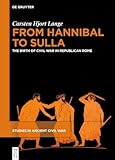From Hannibal to Sulla : The Birth of Civil War in Republican Rome / Carsten Hjort Lange.
Material type: TextSeries: Studies in Ancient Civil War ; 1Publisher: Berlin ; Boston : De Gruyter, [2024]Copyright date: 2024Description: 1 online resource (XII, 218 p.)Content type:
TextSeries: Studies in Ancient Civil War ; 1Publisher: Berlin ; Boston : De Gruyter, [2024]Copyright date: 2024Description: 1 online resource (XII, 218 p.)Content type: - 9783111333090
- 9783111335278
- 9783111335216
- Archaeology and history -- Italy -- Rome
- City and town life -- Italy -- Rome -- History
- Excavations (Archaeology) -- Italy -- Rome
- Urbanization -- Italy -- Rome -- History
- Bürgerkrieg
- Punischer Krieg ‹218 v. Chr.-201 v. Chr.›
- Römerzeit
- Römisches Reich
- Civil war
- Roman Empire
- Roman time
- Second Punic War
- 937/.63 23
- DG62.5 .L364 2024
- online - DeGruyter
- Issued also in print.
| Item type | Current library | Call number | URL | Status | Notes | Barcode | |
|---|---|---|---|---|---|---|---|
 eBook
eBook
|
Biblioteca "Angelicum" Pont. Univ. S.Tommaso d'Aquino Nuvola online | online - DeGruyter (Browse shelf(Opens below)) | Online access | Not for loan (Accesso limitato) | Accesso per gli utenti autorizzati / Access for authorized users | (dgr)9783111335216 |
Frontmatter -- Editorial Statement -- Acknowledgements -- Contents -- Introduction -- Chapter 1 Antebellum and the Illusion of Stability -- Chapter 2 The (Great) War Before the (Civil) War: Hannibal’s Legacy Revisited -- Chapter 3 The Bacchanalian Affair of 186 BCE -- Chapter 4 The Internal War at Patavium 174 BCE -- Chapter 5 Polybius and his Digression on the Truceless War -- Chapter 6 Lucius Opimius and the Rebellion of Fregellae -- Chapter 7 From the Gracchi to the Social War and Rome’s First Civil War I. The Case of Appian -- Chapter 8 From the Gracchi to the Social War and Rome’s first civil war II: A New World Dawns -- Epilogue -- Bibliography -- Index Locorum
restricted access online access with authorization star
http://purl.org/coar/access_right/c_16ec
The second century BCE was a time of prolonged debate at Rome about the changing nature of warfare. From the outbreak of the Second Punic War in 218 to Rome’s first civil war in 88 BCE, warfare shifted from the struggle against a great external enemy to a conflict against internal parties. This book argues that Rome’s Italian subjects were central to this development: having rebelled and defected to Hannibal at the end of the third century, the allies again rebelled in 91 BCE, with significant consequences for Roman thought about warfare as such. These "rebellions" constituted an Italian renewal of the war against their old conqueror, Rome, and an internal war within the polity. Accordingly, we need to add 'internal war' to the already well-established dichotomy of foreign and civil war. This fresh analysis of the second century demonstrates that the Roman experience of internal war during this period provided the natural stepping-stone in the invention of civil war as such. It conceives of the period from the Second Punic War onward as an 'antebellum' period to the later civil war(s) of the Late Republic, during which contemporary observers looked back at the last 'great war' against Hannibal in preparation for the next conflict.
Issued also in print.
Mode of access: Internet via World Wide Web.
In English.
Description based on online resource; title from PDF title page (publisher's Web site, viewed 20. Nov 2024)


